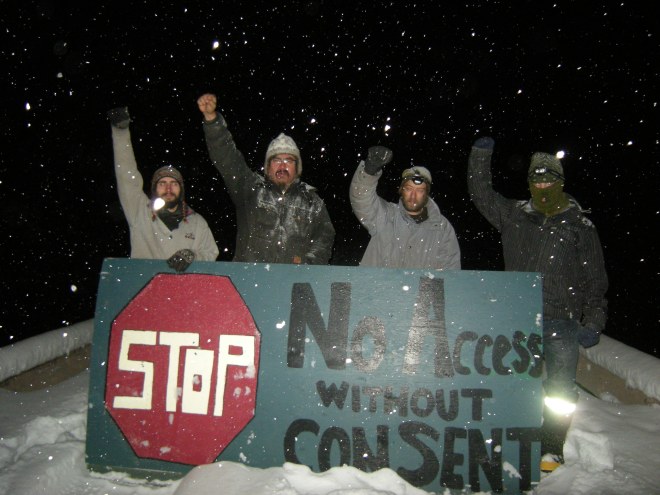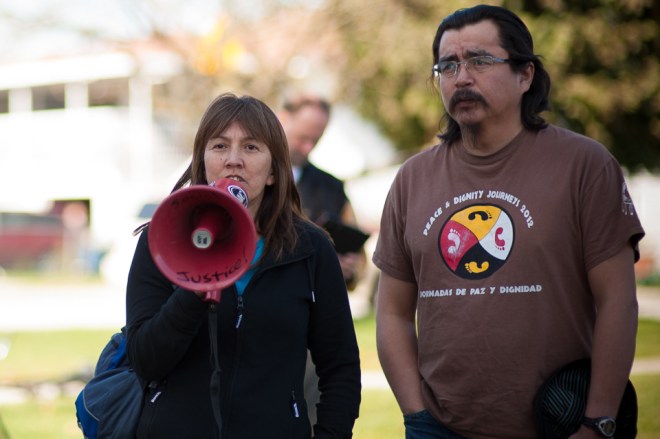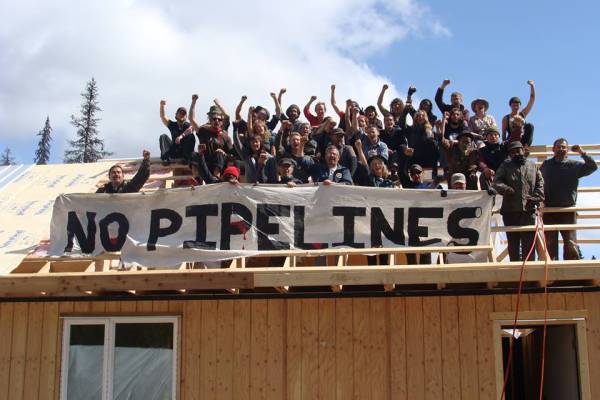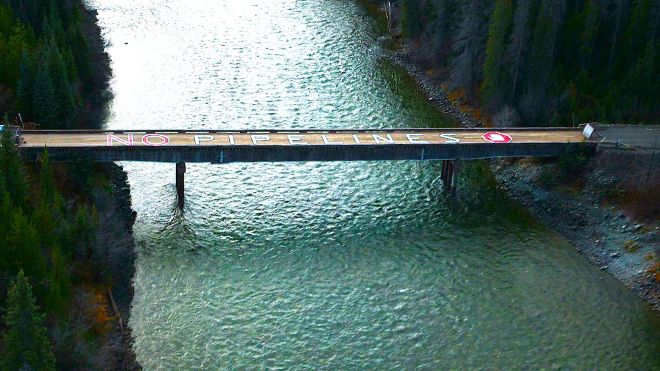The Unist’ot’en Camp, an indigenous-led pipeline blockade in remote, mountainous central British Columbia, is permeated with the savory smell of bear poutine pizza — shredded bear meat, homemade French fries, green onions, and cheese on a scratch whole wheat crust. Ambrose Williams, a member of the nearby Gitxsan nation, is cooking dinner tonight for his partner Erin’s birthday. Because it’s a special occasion, someone has ventured down into the work-in-progress root cellar to excavate a jar of spicy dill pickles made from cucumbers grown in the camp garden.
An enormous pot of water collected from the river heats on a wood-fired stove top, to be used for dishwashing and cooking. To the left of the stove, chopped firewood and kindling pile up in shelves that must be restocked every few days from the log heap just outside this main cabin. Beyond that, a screen on the wall displays the charge level of the camp’s row of 12-volt batteries, which store energy harvested by south-facing solar panels propped up on the steep-pitched metal roof. The Unist’ot’en Camp lies so far north that the panels sit nearly vertical; for much of the year the sun doesn’t venture far above the southern horizon.
The camp, formed in 2010, occupies territory that has belonged to the Unist’ot’en people since time immemorial, according to the clan’s oral history. Several planned pipelines threaten to transport tar-sands oil and fracked natural gas through this land to export terminals on Canada’s west coast. The Canadian government and oil companies are eager to pass through the blockade, and test it regularly.
Before I got here, I heard a lot of stories about the Unist’ot’en Camp. None of them mentioned bear poutine pizza (which is delicious), or chores, or the late-night card games that follow dinner most evenings. Portrayals of the camp — even from those who support it — tend toward the dramatic. Take this Al Jazeera video where masked Unist’ot’en campers dressed in head-to-toe camo gear confront a helicopter pilot attempting to survey the land for TransCanada, the same pipeline company behind the controversial Keystone XL project.
Depending on whom you talk to, the Unist’ot’en are either terrorists-in-waiting (according to a confidential Royal Canadian Mounted Police report leaked last year), a bunch of testosterone-filled young anarchists running around wearing masks and carrying firearms (according to other activists unnerved by the group’s militancy), or heroic eco-warriors fiercely defending unceded First Nations land from a team of mega-villain oil and gas pipeline companies.
I am here because — like a lot of young idealists — I want to support indigenous land struggle. I want to slow down the fossil fuel industry. I want to drink water from an unpolluted river with others interested in learning about living from the land in a small-scale real sharing economy. Fighting something as big as climate change feels abstract. I want to participate in something, for once, that makes a tangible difference.
In late March, I meet three activists in Vancouver and we drive north, through jagged mountains so steep they seem to break the laws of physics. The ranges are a patchwork of clearcuts, and I wonder how logging equipment could manage such vertical slopes. After a day and a half, we enter drier country, dotted with ponderosa pines. Cattle ranches and orchards line the wide waterway of the Fraser River, and rural towns pop up every so often, many simply named after their milepost on the highway – 70 Mile House, 108 Mile Ranch.
We drive into the woods, past small mining operations and massive sawmills, stopping for a meal in Prince George, a logging city that seems impossibly far north for an urban agglomeration of almost 100,000. Somehow, we are only halfway up British Columbia.
We turn west down Highway 16 — also known as the Highway of Tears, for the women, many of them indigenous, who have disappeared along the highway over the last half century. At the tiny town of Houston, B.C., we turn south, climbing a bumpy logging road. After 40 miles of roads that alternate between muddy, slushy, and frozen, we reach a piece of plywood blocking access to a bridge over the Morice River (as Canada calls it) or the Wedzin Kwah (as the Unist’ot’en call it). “STOP,” the sign reads. “No access without prior consent.”
The wooden bridge serves as a border between Canada and the traditional territory of the Unist’ot’en. Like many First Nations groups in British Columbia, the Unist’ot’en never signed treaties relinquishing their land to Canada. This didn’t stop Canada from forcing them onto reserves over a hundred years ago, but it gives the Unist’ot’en a degree of power in the present day.
Last year, Canada’s Supreme Court ruled that any First Nation land that was never formally ceded to the Canadian government can’t be developed without consent of those First Nations that have a claim to it. This would seem to give the Unist’ot’en the freedom to stop the pipeline. In reality, nobody’s quite sure what is going to happen. The Unist’ot’en first blocked the bridge in 2010 and since then, the camp has continued to expand, deliberately, in the path of several future oil and gas pipelines.

The camp knows that we’re coming, but there’s still a protocol to follow. We wait by the stop sign and honk the car horn until two campers come out to the bridge to ask us a series of questions: What are our names? Where are we from? How long do we plan to stay?
The questions are part of the camp’s reimagined version of the ancient Free, Prior, and Informed Consent protocol, which is enshrined in the United Nations Declaration on the Rights of Indigenous Peoples. Have we ever worked for government or industry that has harmed this territory? How will our visit benefit the Unist’ot’en people? A little intimidated, I mutter something about being a journalist.
Our nine-day visit supports the Unist’ot’en Camp practically as well as politically. On our second night in camp, while my fellow visitors shovel snow and build a counter for the kitchen, I go to the frigid Wedzin Kwah to collect water. As I lug heavy plastic jugs full of ice-cold water up the snowy hill to the main cabin, the opportunity feels special, a rarity for a suburban kid like me. I realize I’ve never lived near a stream clear enough to drink from. This strikes me as completely nuts, considering I’ve grown up entirely in the sopping-wet Pacific Northwest.
Bringing water up from the river by hand leads everyone to use water thoughtfully. There are 12 people at the camp, and during my stay, all of our daily cooking, cleaning, and drinking is accomplished with about 40 gallons — a quantity that a showerhead with the EPA’s WaterSense label would run through in 20 minutes.
Here, human energy often does work that fossil fuels would make easy. The camp uses wood for heating and much of its cooking, but since the camp has to harvest trees from the forest, dry out logs for months, chop them up, build a fire, and keep it burning, wood is used conservatively. The same is true of electricity — otherwise, when the sun disappears for too long and the electricity storage runs low, campers have to fire up the gasoline-powered generator.
The community is a sober space, which doesn’t make the evenings any less fun, just easier to remember in the morning. It’s rare and refreshing to spend so much time with other young adults in the absence of mind-altering substances.
In the middle of winter, the snow is so deep that the camp has to use snowmobiles for its once-a-week supply runs in and out of the camp. Summer is busy season, when hundreds of activists make the journey to work at the camp or participate in direct-action training, and pipeline companies show up to attempt to survey the land. Meanwhile, the Canadian government ramps up surveillance of the area.
The next night, all 12 of us are scraping the last bits of delicious preserved moose meat off the kitchen’s mishmash of plates, when we hear something unexpected outside the cabin: footsteps. Williams stands up from the table and opens the door before the man on the other side can even knock.
“I’m here to visit the camp,” is all I hear the man at the door say. Williams tells him that he needs to return to the far side of the bridge and wait for representatives, according to protocol. As they shut the door, Williams and Maariu Costa, the two camp residents who met my group at the bridge three days before, hurriedly pull on jackets and boots and head out to investigate.
Uninvited guests are treated with suspicion at the camp. The 8,500-square-mile territory of the Wet’suwet’en, the larger First Nations group that the Unist’ot’en are a part of, sits at a choke point between the Canada’s vast energy resources and the world economy, a connection that Canada’s Conservative government is hell-bent on making. The Unist’ot’en Camp obstructs the pathway that crude oil from the Alberta tar sands and fracked gas from inland B.C. would take to reach the energy markets of Asia. Faced with obstacles in its quest to become a global energy superpower, the Canadian government has demonstrated that no measure is too drastic, from spending millions of public dollars promoting tar-sands oil to offering First Nations “deals” that extinguish their claims to vast swaths of traditional land.
Frighteningly, Canada’s newest anti-terror legislation, the Patriot Act-like Bill C-51, has language broad enough to designate communities like the Unist’ot’en — who not only take direct action against fossil-fuel infrastructure, but train other people to do so — as terrorists, meaning they could be “preventatively” detained for crimes they “may” commit. An internal intelligence report by the Royal Canadian Mounted Police (RCMP), leaked to Greenpeace, characterizes the camp as having links to “a growing, highly organized and well-financed, anti-Canadian petroleum movement” that includes “violent aboriginal extremists.” Just two days ago, a helicopter flew over the camp twice, just above the treeline, prompting campers to take to the territory on snowmobiles in search of signs that the chopper had attempted to land.
The camp is permeated by a security culture designed to minimize risk when government or industry targets the blockade. Camp members try not to use names when communicating via radio and don’t identify people who are at the camp. If the camp is raided by law enforcement, a “bridge team” of folks willing to be arrested races to put themselves between the law and the rest of the camp.

Camp members stop surveyors, Nov. 20, 2012.Deep Green Resistance Seattle
A consequence of maintaining such a culture is that it can be uncomfortable even to ask where people are from or about other actions they may or may not have participated in. When I ask Maariu Costa if this protocol makes it difficult to build alliances, since we can’t always be open with information, Costa makes a good point, in typical concise fashion: “The best way to build alliances is in person. And with security culture the best way to do it is in person anyway. It doesn’t change much.”
This time, the intruder is nowhere to be found when we trudge around outside to survey the grounds. Tire tracks in front of the sign blocking the bridge suggest a hurried three-point turnaround.
Why would someone drive 40 miles up a remote, muddy road only to turn around when asked to wait? Was he law enforcement? Or was he an energy company employee, sent in to get a quick head count of the camp’s current population?
The following morning, Williams tells us he has found the mysterious visitor — on Facebook. He’s former president of the Haida Association. Williams is mystified. The Haidas have something of a history of conflict with the Wet’suwet’en. But First Nations all along the proposed fossil fuel pipeline routes in B.C. oppose the projects. “It might have been just a drop-in to say hello and see the camp,” Williams says. But then, why take off?
The group decides that from that point forward, at least one person will be on “bridge duty” at all times. The summer-camp-in-the-winter feel of the first three days of my visit is over.
The Unist’ot’en aren’t just out to block the growth of the old fossil-fueled world. They are developing the sort of self-sufficient community we need for fighting climate change — the “real sharing economy” that I keep on seeking out as a journalist. But when I ask Williams about how the camp is actively creating and exploring new ways of living together, he corrects me: “This is not a camp. It’s a home. It’s Freda and Toghestiy’s home.”
Freda Huson is a member of the Unist’ot’en house of the Gilseyhu, (Big Frog) clan. Her husband, Dini Ze Toghestiy, is from the nearby Likhts’amisyu (Fireweed) clan. The two want the camp to give their people the opportunity to reconnect with the land their ancestors lived on, and lived from, for thousands of years. But when they began building their first cabin in 2010, they also made sure to build it directly on the GPS route of Enbridge’s planned Northern Gateway tar-sands pipeline.
Huson is happy to host non-indigenous people and grateful for the hundreds of environmental activists who have shown up at the camp since it was founded, but she’s careful to set the Unist’ot’en apart from their visitors: “We’re not environmentalists,” Huson says. “We just protect the land because we know the land sustains us.”
To Huson, the camp’s reputation for militancy is undeserved. “The media always, always … makes it look like the indigenous people are the ones that are being aggressive,” she says. “And all they’re doing is peacefully drumming, women and children standing to protect their land — and they [the government] send in the RCMP who pepper-spray them and get very aggressive with them, which of course forces the men to stand up for the ladies, women, and children. And the media twists this.”

Freda Huson and Dini Ze Toghestiy at a Chevron protest in 2013. Caelie_Frampton
The Wet’suwet’en have done this before. With the Gitxsan nation, they blockaded logging roads all over their traditional territories in the 1980s, an action which culminated in the Delgamuukw decision of 1997. The result was a landmark ruling by the Supreme Court of Canada, which held that aboriginal title is protected by the constitution and oral history can be presented as evidence of title. The decision acknowledged that about three-quarters of B.C. had never been ceded to Canada and recommended that negotiations begin to settle ownership disputes between settler states occupying these territories and the indigenous peoples who have never signed them over.
Terry Glavin, author of A Death Feast in Dimlahamid, a book about that court case, has spent considerable time at blockades against timber extraction companies that had not consulted with tribal governments before logging. Despite being a long-time supporter of, and participant in, indigenous direct actions, Glavin is not convinced that the law as it’s been interpreted gives indigenous people the right to stop pipelines. The Delgamuukw decision, from 1997, reads: “aboriginal title and aboriginal rights are based on the customs, traditions and practices of the aboriginal people to the extent that those customs, traditions and practices were an integral part of their distinctive culture.”
“So the question is this,” says Glavin. “What Wet’suwet’en customs, traditions, and practices would a pipeline impinge upon? Probably none.”
Freda Huson thinks otherwise. “There’s going to be like a wide area that’s fully cleared of its trees and our berries and our medicines, and they’re not going to be allowed to grow back,” she says. “And all of the animals won’t go there, so they’ll be forced out into other areas, so that’ll impact our ability to hunt and harvest our own food. We can’t just go to anybody’s land and go hunt — that’s against our customs. We only hunt, fish, trap on our own territory.”
A public opinion poll from Bloomberg-Nanos last year shows that a majority of B.C. residents want the provincial government to kill, or at least delay, the Northern Gateway pipeline, which would carry tar-sands crude. But other proposed pipelines that the Unist’ot’en Camp is blocking will deliver Liquefied Natural Gas (LNG). Even though LNG is extracted with highly controversial hydraulic-fracture methods, it might not face the same unified opposition. And, in practice, the ability of Canada to infringe upon aboriginal title for purposes of infrastructure is enormous. Large swaths of indigenous land have been expropriated by the Crown for other transportation projects.
Huson is optimistic that First Nations peoples will stand united against these projects. “They’re planning to go through five clan territories, and four of the five clans have publicly announced that they’ve said ‘no’ to all pipelines, not just Enbridge.”
Leah Temper, an ecological economics professor at the Autonomous University of Barcelona who’s finalizing a documentary film about the camp, sees the legal situation differently than Glavin. The blockade isn’t illegal, Temper says — according to Canadian law, the Unist’ot’en can shut down extractive industry in a way that environmental activists and other indigenous peoples often are not able to. “The last court case left things very open,” she says. “They do have territorial sovereignty over their land, but what this means has not been established.”
The Indian Act of 1876 set up a system of band councils to govern the reserves that First Nations were pushed onto. Huson strongly repudiates any authority that a band council might claim over Unist’ot’en land. “Some of the people have lost a lot of their governance systems,” she says. “Because we were one of the larger Wet’suwet’en communities, we were able to hang on to it.”
Instead of yielding authority to band councils put in place by the Canadian government, the Unist’ot’en make decisions through their traditional system of hereditary chiefs. Huson describes herself as their spokesperson: “Our chiefs are the ones that have the final decision-making.”
Even though the Delgamuukw decision affirms the hereditary governments’ sovereignty over Wet’suwet’en and Gitxsan territories, energy companies have done all they can to avoid seeking approval. Even staff from Canada’s environmental ministry admit that First Nations were not involved in the consultation process for Enbridge’s proposed Northern Gateway tar-sands pipeline, which was conditionally approved by the federal government in 2013, but still faces significant legal and political challenges.
Indian Act band councils don’t have the power to greenlight development projects beyond the reserves, but when forced to consult with First Nations, pipeline companies have persistently chosen to negotiate with band councils rather than the traditional governments whose territories their infrastructure would cross. Chevron formed the First Nations Limited Partnership with several band councils to give financial benefits, shares, employment opportunities, and contract opportunities in exchange for their blessing to build the Pacific Trails Pipeline. On Jan. 23, 2015, the Moricetown Band — the band council that claims to represent the Wet’suwet’en nation — became the 16th and final First Nations band along the pipeline route to sign on to the partnership. In exchange, the 16 bands will share 32 million Canadian dollars (U.S. $24.6 million) once construction begins, as well as $CA 10 million ($7.7 million) per year while the pipeline is operating.
When the negotiations between the Moricetown Band Council and Chevron were revealed last November, one of the most disturbing revelations to the Unist’ot’en was that the pipeline could easily be converted to carry diluted bitumen — tar-sands oil — after five years of operation as a fracked gas conduit.
On Aug. 6, in response to increasing encroachment on the camp from the RCMP and industry, all five Unist’ot’en chiefs, along with four other Wet’suwet’en chiefs, signed the Unist’ot’en Declaration, a document that seeks to clear up confusion about the camp. The Declaration mainly reaffirms the convoluted legal circumstances – that the land is unceded, the Supreme Court has recognized Aboriginal title, and all activity must be consented to by the Unist’ot’en – by officially enacting them as law. First, though, the new decree declares, “The Unist’ot’en settlement camp is not a protest or a demonstration. Our clan is occupying and using our traditional territory as it has for centuries.”
“The only thing that’s going to stop this is if the corporations themselves stop it,” says grassroots organizer Zoe Blunt. “And the only way they’re going to stop it is if they can’t make any money.”
Blunt coordinates the ongoing activist caravan to the Unist’ot’en Camp, helping folks fill out the online form to sign up to volunteer (and get started on the ‘prior’ part of the Free, Prior, and Informed Consent Protocol for entering the territory) and then arranging rideshares. She’s a fundraiser, writer, editor, litigant, speaker, and campaigner with experience at Greenpeace and the Canadian Red Cross. Blunt founded the Vancouver Island Community Forest Action Network and is currently finishing up a book called Pros and Cons of Tree-spiking: A fair and balanced look at eco-sabotage in British Columbia.
To Blunt, direct action and legal action against the fossil fuel industry work mainly because they increase the price of getting fuels to market, making new ventures like pipelines less and less profitable as activists get in the way at every opportunity.
“People don’t just throw money in a hole in the ground; they expect to get it all back, plus a dividend,” she says. “And, you know, it’s not that profitable taking oil out of the ground, especially tar sands bitumen.” (Especially right now, as oil is cheaper than it’s been in years.)
Blunt continues: “The only advantage that Canada has over other places in the world is that this is not a war zone. You know, ’cause in places like the Philippines, Ukraine, Mexico, and Ghaza, they destroy pipelines. There are people down to vandalize and blow up pipelines everywhere, all over the world, every week. You can Google it if you don’t believe me.”
After the Unist’ot’en put up their first building in the path of the Northern Gateway pipeline, Enbridge shifted the pipeline’s route. In response, the blockade community built a pithouse — directly in the way of the new route. A pithouse is wood-frame circular building, dug several feet into the earth and then covered with soil. Seen from a distance, it looks like a mound of dirt — but the thick walls provide temperature regulation through the cold winters and hot summers. It’s a kind of architecture that First Nations have used in British Colombia for thousands of years. When this one is finished, it will be Freda and Toghestiy’s new home.
On the outside, the pithouse will look like a traditional dwelling. The interior will resemble a modern house, with kitchen countertops, cabinets, and separate living and sleeping quarters. “We’re going to try and make it contemporary so that we can show our people that they can build their own homes out on the territory so they can start moving back to the land because, right now, every reserve has a shortage of housing,” says Huson.
Huson dreams of pithouses all over the territory. She would love for the elders to return home, for her people to once again be fed by their land. She’s exasperated with the idea that the First Nations depend on government handouts. “That’s not true. They take billions of dollars out of our territory annually through resource-extractive industry via mining, logging, fishing. Yes, they give us these crumbs, and even out of those crumbs they’ve been clawing them back to impoverish our people even more.”
To make the dream Huson describes come true, the Unist’ot’en are focusing on indigenous youth. Between 1883 and 1998, the Canadian government financed boarding schools for First Nations children that were created with the explicit goal to “take the Indian out of the child.” A report released this year by Canada’s Truth and Reconciliation Commission described the schools as “cultural genocide.” Huson describes the Unist’ot’en Camp’s newest project, constructing a healing center, as a direct counterpoint to this — trying to “put the Indian back in the child.”
It will take some time for the community to reach its goal of being self-sustaining. First, a healthy woodland ecosystem will have to be restored. The forests that cover the Unist’ot’en territory today are a patchwork of clearcuts and chillingly sterile monoculture that’s been devastated by mountain pine beetle. But this year is the last year that commercial logging operations will take timber from the land, Huson tells me. “Right now we’re growing conventional vegetables, like root vegetables. But once the soil is established, we want to start transplanting our berry bushes and some of our medicines into the permaculture garden,” she says. At any time of year, the blockade has enough food stored in the root cellar, various tubs of dried goods, a smokehouse, and a few freezers to feed dozens of residents for several months, in case it’s ever cut off from outside.
“If you don’t know how to live off the land, you’re going to be the first people to go.” Huson said once, in an interview. “The ones who have always lived modestly, and knew how to take care of themselves, and didn’t rely on anybody else to sustain their own families, they are the only people that are going to survive.”
After spending nine days at the Unist’ot’en Camp, I can confidently say that it isn’t a terrorist cell. Really, the camp is a sort of utopian project. It embodies the possibility of a world where citizens wake up in the morning and do the work they love, whatever that may be, toward goals they believe in, and then share meals and good times and a common cause. The blockade community exists apart from bosses and wages and expert decision-making committees. It doesn’t fit into economists’ models where property owners sell development rights according to their “willingness to accept compensation.”
And that’s exactly what’s so threatening about the Unist’ot’en Camp. The Unist’ot’en have declared that — at least as far as the oil and gas industry is concerned — the value of the land can’t be measured in money. And they won’t give “yes” for an answer.






